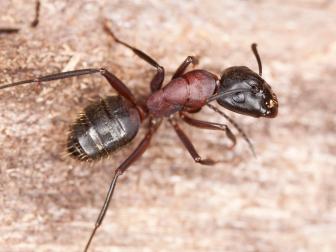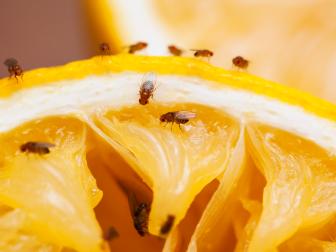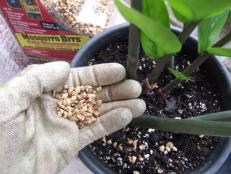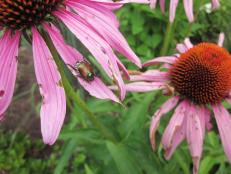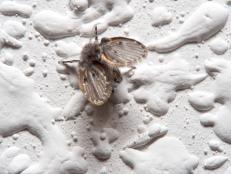How to Get Rid of Crickets
Chirping crickets can drive you crazy if they get indoors, and they can damage your home. Large numbers of crickets can harm yards and gardens, too. We've got the tips you need to get rid of crickets.

Shutterstock/forest71
Because crickets such as this house cricket (Acheta domestica) are omnivorous, they will feast on wool, silk and other fabrics and even wallpaper glue and bits of food they find in your home.

In some parts of the world, crickets are a sign of good luck. But for most of us, they’re noisy insects that can damage our homes or yards. We usually hear chirping crickets before we see them, especially indoors. And when they keep us awake at night, we want to know how to get rid of crickets.
It helps to know what kind of crickets you have. There are over 900 species of crickets (family Gryllidae) worldwide. Birds and animals often eat these distant relatives of grasshoppers, and humans like them, too; deep-fried crickets are popular in Thailand, Mexico and other countries. They’re rich in protein and other nutrients and can be used as a sustainable alternative to common meats.
Crickets in the House
Crickets are drawn to your home by food, lights (especially at nighttime) and warm places that offer shelter from bad weather. They get in through cracks, crevices and holes in your foundation, siding, walls and roof as well as through ripped screens, and open windows and doors. Crickets in the roof enter through vents and other small openings.
The most common crickets you'll find in your homes are the field cricket (Gryllina spp.), the camel cricket (Rhaphidophoridae) and the house cricket (Acheta domestica).
What Do Crickets Look Like?
Most crickets have six legs, two thin antennae, long hind legs used for jumping and cylinder-shaped bodies. They range from 1/12 of an inch to 2 inches long and vary in color from black to tan, yellowish and green. Males rub their wings together (not their legs) to make a chirping sound and attract females. Some species don’t have wings, so they can’t chirp.
Do Crickets Bite?
In general, crickets are not dangerous. Their small jaws are usually too weak to puncture human skin — but because crickets can carry pathogens, bites can lead to infections. Also, some people are allergic to crickets. Don't let your pets eat crickets or cricket waste, which can make them sick.
The Lifespan of a Cricket
Most female crickets lay their eggs in loosened, moist outdoor soil; they don’t breed indoors. The eggs overwinter and hatch the following spring. When the nymphs emerge, they start to eat and molt repeatedly until they mature and develop wings.
Several generations can hatch each spring and summer, but most species live from spring into fall and die when the outdoor temperatures drop.
How long do crickets live? Indoors, most die within a few months. Outdoors, the lifespan of a cricket ends with the arrival of winter weather.
Do Crickets Harm Yards and Homes?
They can. Outdoors, crickets eat young plants and flowers, but the damage is usually minor unless you have a heavy cricket infestation. Manage them by looking for and removing cricket eggs in the soil around your garden, beds and borders. You don’t want a population boom that can draw unwanted cricket predators like raccoons, spiders and other creatures.
Indoors, crickets live in damp, dark places like basements. Because they’re omnivorous, they’ll feast on wool, silk and other fabrics in your clothes or furnishings, along with paper, wallpaper glue and bits of food. (They’re partial to garbage.)
How to Get Rid of Crickets
If you still have crickets after you’ve sealed any entrances in your home and roof, try these methods to control them:
- Dry out damp spots in your attic, basement, crawl space or other area by using a dehumidifier or improving the air circulation. Remove clutter, too.
- Check for and fix leaks in your plumbing and roof, and repair any leaky taps.
- Clean your gutters regularly to avoid crickets on the roof.
- Vacuum crickets or eggs and toss them away in sealed bags. You’ll usually find these pests around warm places like chimneys and furnaces.
- Let nature help if you’re dealing with crickets outdoors. Frogs, snakes, mice, small birds, rats and other animals will eat them. Big crickets will also cannibalize the small larvae or nymphs of their own species.
- Outdoors, check for crickets and eggs in dark areas under or around your patio or deck, in your compost pile and under planters and mulch. Keep your grass mowed and your garden weeded. Prune trees and shrubs near your entrances. Keep firewood and compost piles at least 20 feet away from your home.
- Switch your outdoor lights to LEDs, bug lights or motion-activated lights. Close your curtains so crickets won’t see the lights in your home.
- Use sprays and baits specifically designed to get rid of crickets and only crickets. Most are sold at home and garden centers or hardware stores. Use the product as directed on the label and keep it away from children and pets.
- Call a professional pest control company if needed.
How to Catch a Cricket
There are several ways to catch a cricket.
- Leave out a plastic bottle that still has a little sweet soda in it. Crickets can crawl in but can’t usually get back out.
- Most of the time, you'll hear a chirping cricket before you spot it. Listen quietly, so you’ll know where it is, and then sneak up on it. Catch it with your hands, remove it from the house and wash your hands thoroughly afterward.
- Glue boards and sticky traps can also trap crickets so you can take them outside.
Types of Crickets
While house crickets are the most common crickets found in the US, you might also encounter these.
Field crickets (Gryllina spp.) You’ll often hear these crickets chirping on warm summer nights. They live in the ground and in organic debris and tall grass, where they eat plant matter and the remains of animals. They can be pests if they chew on ornamental or edible plants, but they also help by eating the eggs and pupae of harmful insects. When startled, they’ll jump and bounce off your legs, but they’re harmless. They’re sometimes called fall field crickets.

Shutterstock/Vinicius R. Souza
Field crickets are beneficial insects when they eat the eggs and pupae of harmful insects in the garden, but they become pests if they chew on ornamental or edible plants.
Mole crickets (Gryllotalpidae) These crickets damage yards and lawns by burrowing in the topsoil; some species eat plant roots, young shoots and seedlings. They have big, front claws that may remind you of moles. Suspect mole crickets if you see patches of dying grass, tunnels or uprooted seedlings. Armadillos and raccoons may show up in yards infested with mole crickets since they like to eat them. Control mole crickets with a pesticide designed to reach them in their tunnels or call a professional pest control company.
Jerusalem crickets (Stenopelmatini spp.) Despite their name, Jerusalem crickets aren’t true crickets. Sometimes called potato bugs or sand crickets, these large insects have six legs and range in color from yellow to brown. Most live in the western parts of the US. They don’t live or breed indoors and you rarely see big outdoor infestations. Their strong jaws can deliver a painful bite, but it isn’t dangerous. They feast on roots and tubers during the day and come out at night to eat other bugs and rotting vegetation (a kind of clean-up that helps the environment). To prevent them, remove piles of wood and rocks, keep mulch several inches away from foundations and repair any damaged weather stripping. Call a professional pest control company if needed.
Camel crickets (Rhaphidophoridae) Also called cave or spider crickets, these insects are named for the camel-like humps on their backs. They live in caves and damp, cool places under rocks, leaves and rotting logs. These wingless insects have six legs and two antennae and range from light to dark brown in color. They don’t bite but can damage clothing, curtains and other furnishing and fabrics if they get into your home. Prevent infestations by removing moisture in and around your home with a dehumidifier, sealing possible entrances and improving ventilation. Keep firewood, organic debris and trash cans away from your home and mow your grass often.
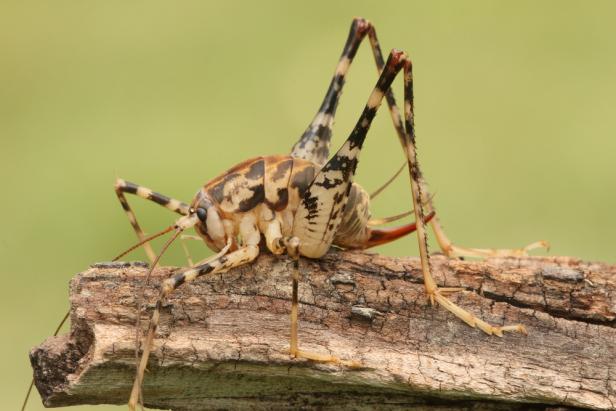
Shutterstock/Steve Byland
Camel crickets, also know as cave crickets, seek damp, dark spots in your home and can damage clothing, curtains and other furnishing and fabrics.
Mormon crickets (Anabrus simplex) Native to western North America, these large wingless insects aren’t true crickets, either; they’re more closely related to katydids. At various times in their lifecycles, they devour tree foliage, fruits, grasses, shrubs, crops and grains. Natural predators like birds, wasps and ground beetles can help control them, and various diseases will reduce their numbers. Chemical controls are the most effective way to eliminate them.
What is the Difference Between a Cricket and a Grasshopper?
In case you're wondering, grasshoppers are active during the day while crickets are nocturnal. Crickets eat almost anything, but grasshoppers are herbivores. Crickets also have longer antennae than grasshoppers.

%20Taniya%20Nayak,%20Ty%20Pennington,%20Alison%20Victoria,%20and%20Brian%20and%20Sarah%20Baeumler_BOTB_HGTV%20.jpg.rend.hgtvcom.196.196.suffix/1683310636672.jpeg)




